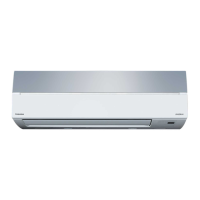
Do you have a question about the Toshiba RAS-10SKVR-E2 and is the answer not in the manual?
| Cooling Capacity | 2.5 kW |
|---|---|
| Heating Capacity | 3.2 kW |
| Noise Level (Indoor) | 44 dB(A) |
| Power Supply | 220-240 V, 50 Hz |
| Type | Split |
| Noise Level (Outdoor) | 49 dB(A) |
Essential safety guidelines for servicing, installation, and general use of the air conditioner.
Details on cooling/heating capacity, electrical characteristics, dimensions, and performance.
Graphs showing cooling/heating performance curves and capacity variation with temperature.
Safety precautions for handling R410A refrigerant during installation and servicing.
Guidelines and materials for installing refrigerant piping with R410A.
List and specifications of tools required for R410A refrigerant handling and installation.
Procedure for recharging refrigerant into the air conditioning system.
Methods and materials for brazing refrigerant pipes, including flux types.
Procedure for brazing pipes to prevent oxidation and ensure proper joints.
Detailed diagrams and dimensions of the indoor unit components and installation.
Detailed diagrams and dimensions of the outdoor unit components and installation.
Schematic diagram illustrating the electrical connections for the air conditioner system.
List of electrical components and their specifications for the indoor unit.
List of electrical components and their specifications for the outdoor unit.
Diagram illustrating the flow of refrigerant through the air conditioning system.
Table showing operational data under various cooling and heating conditions.
Block diagram showing the control logic and components of the indoor unit.
Block diagram of the outdoor unit's control system, including the inverter assembly.
Overview of how the air conditioner's capacity-variable system is controlled.
Detailed description of basic operations, cooling/heating, AUTO, and DRY modes.
Controls indoor fan speed in cooling and heating modes, including AUTO and MANUAL.
Controls outdoor fan speed, capacity, defrost, and current release.
Details protective control, louver, ECO, and air purifying functions.
Covers Remote A/B selection, QUIET, COMFORT SLEEP, and One-Touch modes.
Enables automatic restart with previous settings after power failure.
Details the components, operations, and display indicators of the remote controller.
Diagrams showing placement and mounting details for indoor and outdoor units.
Details optional parts and fixing arrangements for installation.
Lists all accessories and installation parts included with the unit.
Details tools required for installation and servicing, highlighting R410A specific tools.
Guidance on selecting an appropriate location for installing the indoor unit.
Instructions for electrical connections, including power supply and wiring methods.
Step-by-step guide on connecting the power and communication cables.
Procedures for forming refrigerant pipes and installing the drain hose.
Steps for physically mounting and securing the indoor unit to the installation plate.
Instructions for running the drain hose correctly for proper water drainage.
Guidelines for selecting an appropriate location for the outdoor unit.
Procedure for installing water-proof caps and drain nipple for defrost water drainage.
Instructions for flaring copper pipes and connecting refrigerant lines.
Procedure for removing air and moisture from the refrigerant circuit using a vacuum pump.
Steps for connecting power and communication cables to the outdoor unit.
Procedure to check for refrigerant leaks using a leak detector or soapy water.
Procedure to test the system after installation by pressing the RESET button.
Instructions to enable or disable the auto restart function after power failure.
Guides on selecting remote controller A or B for multi-unit installations.
Basic checks for power supply and voltage to confirm initial operation.
Methods for diagnosing troubles, including LED indicators and remote controller checks.
Interprets self-diagnosis codes displayed by flashing LEDs on the indoor unit.
Explains how to use the remote controller to perform self-diagnosis and read check codes.
Troubleshooting based on symptoms, focusing on indoor unit and remote controller issues.
Diagnoses issues related to interconnecting and serial signal wiring between units.
Troubleshooting specific check codes related to miswiring and sensor errors.
Troubleshooting guide for the air purifier function, checking its components and operation.
Procedure to check the functionality of the minus ion generator.
Flowchart for diagnosing issues within the outdoor unit's inverter assembly.
Steps to check the indoor unit's P.C. board for defects and proper connections.
Checking procedures for indoor unit components like sensors and motors.
Checking procedures for outdoor unit components like compressor and sensors.
Specific methods for checking electronic components like capacitors and diode blocks.
Diagnoses the condition of the outdoor fan motor and its potential causes.
Procedures for replacing main parts of the indoor unit.
Procedures for replacing main parts of the outdoor unit.
Exploded view and parts list for the indoor unit.
Exploded view and parts list for specific E-parts of the indoor unit.
Exploded view and parts list for the outdoor unit.
Layout diagram of the Printed Circuit Board components.